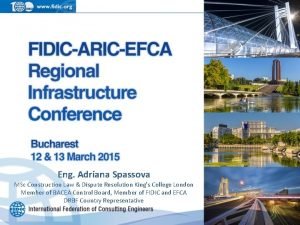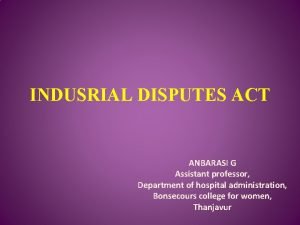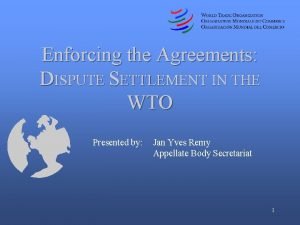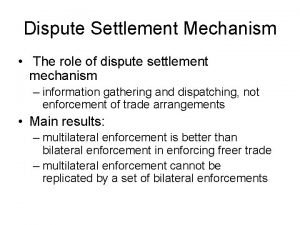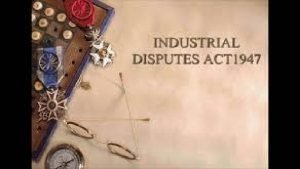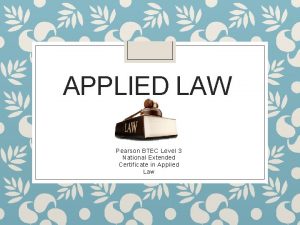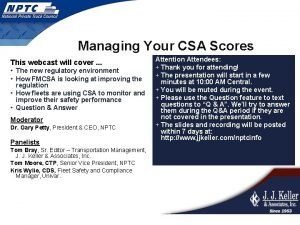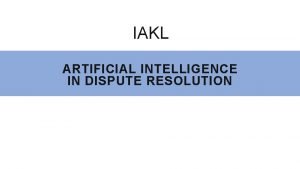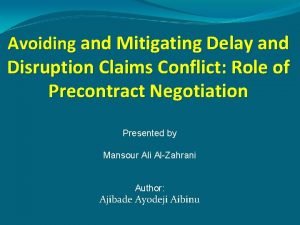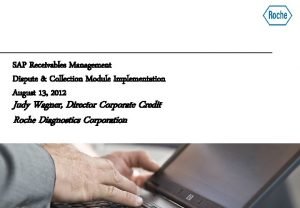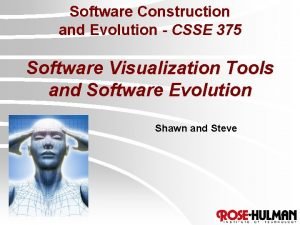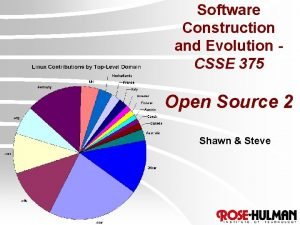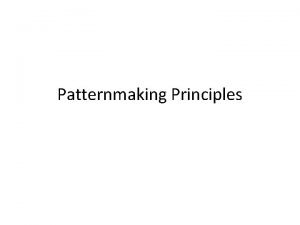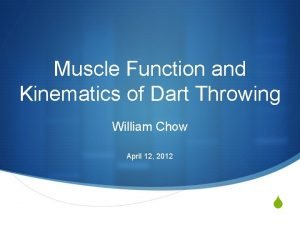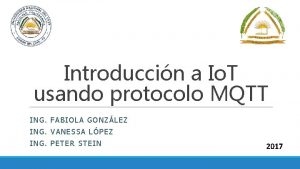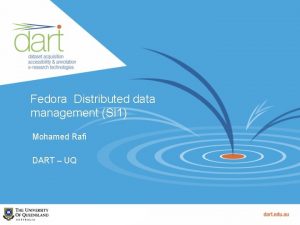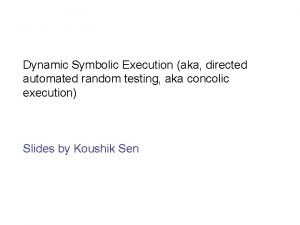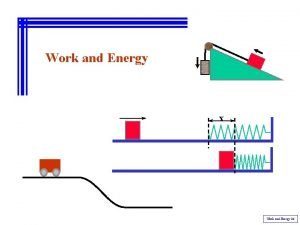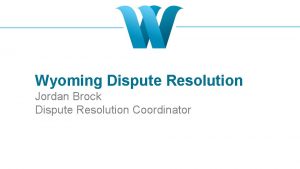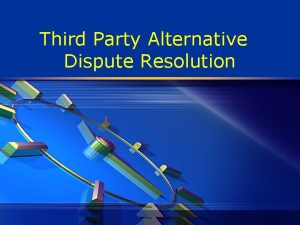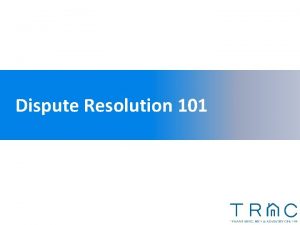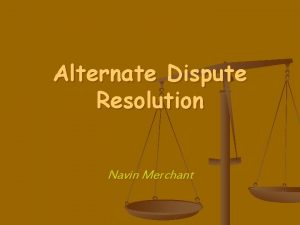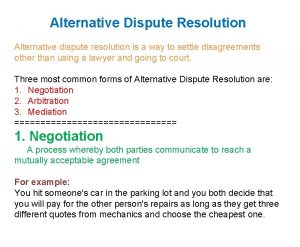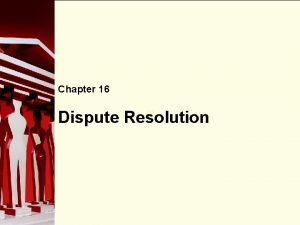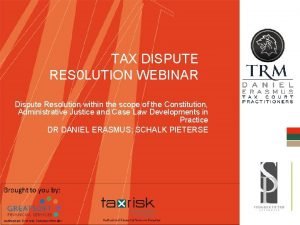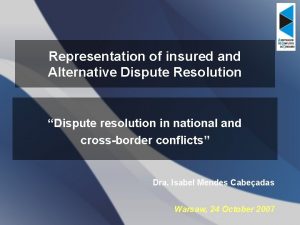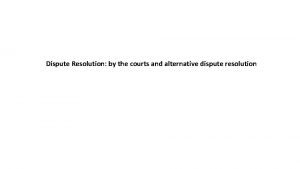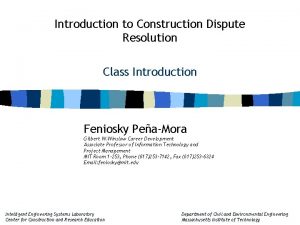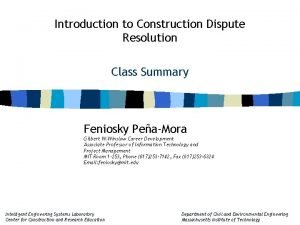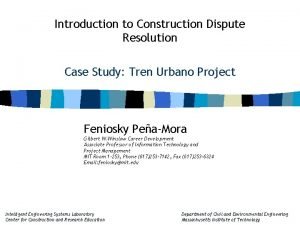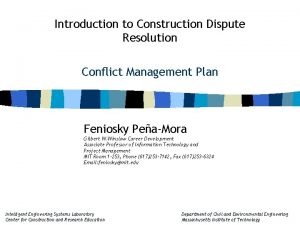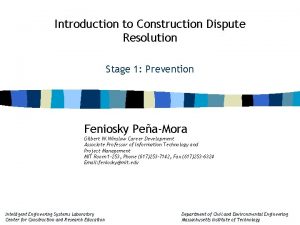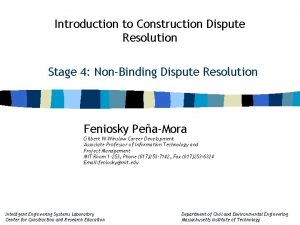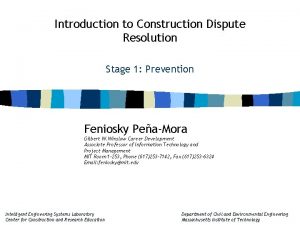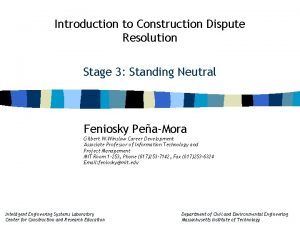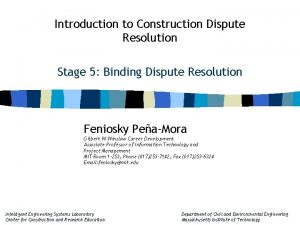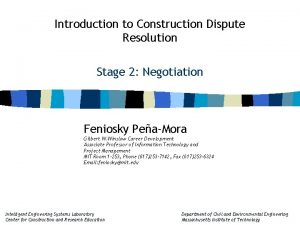Introduction to Construction Dispute Resolution Evolution of DART

































- Slides: 33

Introduction to Construction Dispute Resolution Evolution of DART Feniosky Peña-Mora Gilbert W. Winslow Career Development Associate Professor of Information Technology and Project Management MIT Room 1 -253, Phone (617)253 -7142, Fax (617)253 -6324 Email: feniosky@mit. edu Intelligent Engineering Systems Laboratory Center for Construction and Research Education Department of Civil and Environmental Engineering Massachusetts Institute of Technology

Definitions n WHAT • Evolution of Alternative Dispute Resolution Procedures • Implementation of Mediation, Conciliation and Dispute Review Boards n WHO • Worldwide Practice of ADR (e. g. , Ancient Greece, China) n WHY • Understanding the Reason Behind ADR Procedures for their Effective Implementation n HOW • Review of the Traditional Dispute Resolution Ladder 2 • Study of the Six-step Dispute Resolution Ladder Introduction to Construction Dispute Resolution Chapter 2: Evolution of DART © Peña-Mora, et. al. 2002

Outline Ø Traditional Dispute Resolution in Construction • Determination by the Design Professional • Arbitration n Modification of the Two-Step ADR Approach • FIDIC’s ARD Contract Conditions • World Bank’s ADR Contract Conditions • Chek Lap Kok Airport’s Dispute Resolution System n Evolution of the Present ADR Methodologies • Data Supporting the Evolution of ADR • Two Conceptualization Models of DART 3 n The State of the Legal Construction Arena Introduction to Construction Dispute Resolution Chapter 2: Evolution of DART © Peña-Mora, et. al. 2002

Traditional Dispute Resolution in Construction n Two Tools for Dispute Resolution : • 1 st Tool : Non-binding Determination of a Design Professional • 2 nd Tool : Binding Arbitration (Alternative to Litigation) n Negotiations to Fill the Gap between the Tools 4 Introduction to Construction Dispute Resolution Chapter 2: Evolution of DART © Peña-Mora, et. al. 2002

Dispute Resolution Ladder Peña-Mora, et. al, 2002 5 Introduction to Construction Dispute Resolution Chapter 2: Evolution of DART © Peña-Mora, et. al. 2002

Outline ü Traditional Dispute Resolution in Construction Ø Determination by the Design Professional • Arbitration n Modification of the Two-Step ADR Approach • FIDIC’s ARD Contract Conditions • World Bank’s ADR Contract Conditions • Chek Lap Kok Airport’s Dispute Resolution System n Evolution of the Present ADR Methodologies • Data Supporting the Evolution of ADR • Two Conceptualization Models of DART 6 n The State of the Legal Construction Arena Introduction to Construction Dispute Resolution Chapter 2: Evolution of DART © Peña-Mora, et. al. 2002

Determination by the Design Professional n A/E as Unbiased, Knowledgeable Third Party Resolver in Traditional DBB Projects n Major Concern Leading to the Transformation: Biased A/E and very Complex Projects n Generation of the Concepts of Neutral Advisors and Dispute Review Boards as Substitution to the A/E in the Traditional DRL 7 Introduction to Construction Dispute Resolution Chapter 2: Evolution of DART © Peña-Mora, et. al. 2002

Outline ü Traditional Dispute Resolution in Construction ü Determination by the Design Professional Ø Arbitration n Modification of the Two-Step ADR Approach • FIDIC’s ARD Contract Conditions • World Bank’s ADR Contract Conditions • Chek Lap Kok Airport’s Dispute Resolution System n Evolution of the Present ADR Methodologies • Data Supporting the Evolution of ADR • Two Conceptualization Models of DART 8 n The State of the Legal Construction Arena Introduction to Construction Dispute Resolution Chapter 2: Evolution of DART © Peña-Mora, et. al. 2002

Early Applications of Arbitration n Arbitration Experiences in Greece: Fast Solutions Based on Knowledge and Experience, Flexibility and Finality n Arbitration in Old England (602 -1698): Evolution from a Purely Conciliatory Process to an Adjudicative System 9 Introduction to Construction Dispute Resolution Chapter 2: Evolution of DART © Peña-Mora, et. al. 2002

Arbitration in the Construction Industry n Arbitration as Substitute to Litigation in Many Association Standard Contracts (e. g. AIA, AGC, CIOB, WB and FIDIC) n Arbitration Becoming an Adversarial Procedure Due to Increasing Pressures and Strains 10 Introduction to Construction Dispute Resolution Chapter 2: Evolution of DART © Peña-Mora, et. al. 2002

Problems with Arbitration Problems Reflected in ABA Results 1. Problems regarding the speed and efficiency of arbitration in larger cases, which made arbitration expensive. 2. Need to consider mechanisms to deal with multiparty disputes. 3. Problems regarding the quality of construction arbitrators. Arbitration Features (Economy and Flexibility) (Economy, Knowledgebased decisions and Flexibility) 4. The need to support greater use of preliminary hearings and pre-arbitration orders to organize and expedite the actual procedure (Economy) 5. The need to increase the power of the arbitrator to order sanctions for delays and ‘non-cooperation’. (Economy and Flexibility) 6. Objections as to the appropriateness of a written award by the arbitrator explaining the reasons for the decision. (Privacy) Stipanowich 1996 11 Introduction to Construction Dispute Resolution Chapter 2: Evolution of DART © Peña-Mora, et. al. 2002

Confucian Philosophy n A Common Ground for Negotiating Settlement and Preserving the Harmonious Relationship n Dispute Resolution Process Based on “…the Confucian view that the optimum resolution of a dispute should be attained by moral persuasion and compromise instead of by sovereign coercion” (Chau, 1992) 12 Introduction to Construction Dispute Resolution Chapter 2: Evolution of DART © Peña-Mora, et. al. 2002

Outline ü Traditional Dispute Resolution in Construction ü Determination by the Design Professional ü Arbitration ü Modification of the Two-Step ADR Approach Ø FIDIC’s ADR Contract Conditions • World Bank’s ADR Contract Conditions • Chek Lap Kok Airport’s Dispute Resolution System n Evolution of the Present ADR Methodologies • Data Supporting the Evolution of ADR • Two Conceptualization Models of DART 13 n The State of the Legal Construction Arena Introduction to Construction Dispute Resolution Chapter 2: Evolution of DART © Peña-Mora, et. al. 2002

FIDIC, 1957 (Federation Internationale des Ingenieurs-Conseils) n Deferment of Claims Resolution Until the End of the Project n Implementation of the Two-step Traditional DRL • A/E Determination • Arbitration 14 Introduction to Construction Dispute Resolution Chapter 2: Evolution of DART © Peña-Mora, et. al. 2002

FIDIC’s ADR Contract Conditions n Shift toward Early Treatment of Claims in New Editions (Starting in 1987) Claims Notification Process n Introduction of the Requirement to Attempt an “Amicable Settlement” before Arbitration 15 Introduction to Construction Dispute Resolution Chapter 2: Evolution of DART © Peña-Mora, et. al. 2002

Outline ü Traditional Dispute Resolution in Construction ü Determination by the Design Professional ü Arbitration ü Modification of the Two-Step ADR Approach ü FIDIC’s ARD Contract Conditions Ø World Bank’s ADR Contract Conditions • Chek Lap Kok Airport’s Dispute Resolution System n Evolution of the Present ADR Methodologies • Data Supporting the Evolution of ADR • Two Conceptualization Models of DART 16 n The State of the Legal Construction Arena Introduction to Construction Dispute Resolution Chapter 2: Evolution of DART © Peña-Mora, et. al. 2002

World Bank’s ADR Contract Conditions n Dispute Review Board (DRB) to Replace the Engineer or Review his/her Decisions before Arbitration in Complex Contracts n Adjudicator to Resolve Disputes in the First Instance in Small Contracts (Instead of A/E) • Appointed Jointly by the Owner and the Contractor to Resolve Disputes • Adjudicator’s Decision to Be Submitted within 28 Days of the Dispute • Adjudicator’s Decision Becoming Final and Binding if not Deferred to Arbitration within 28 Days of Its Receipt 17 Introduction to Construction Dispute Resolution Chapter 2: Evolution of DART © Peña-Mora, et. al. 2002

Outline ü Traditional Dispute Resolution in Construction ü Determination by the Design Professional ü Arbitration ü Modification of the Two-Step ADR Approach ü FIDIC’s ARD Contract Conditions ü World Bank’s ADR Contract Conditions Ø Chek Lap Kok Airport’s Dispute Resolution System n Evolution of the Present ADR Methodologies • Data Supporting the Evolution of ADR • Two Conceptualization Models of DART 18 n The State of the Legal Construction Arena Introduction to Construction Dispute Resolution Chapter 2: Evolution of DART © Peña-Mora, et. al. 2002

Dispute Resolution for Government Contracts in Hong Kong (1998) 1 Architect/Engineer or 2 3 Mediation Arbitration Supervising Officer Parties have 28 days Parties can request arbitration 90 to refer the matter to days after failing to agree through mediation, but not before the job is complete 19 Introduction to Construction Dispute Resolution Chapter 2: Evolution of DART © Peña-Mora, et. al. 2002

Chek Lap Kok Airport’s Dispute Resolution System (1998) Parties have 28 days to refer the matter to mediation Parties have 42 days to Adjudicator has 28 days to resolve the matter issue a final and binding through mediation determination from the time 1 A Architect/Engineer or Supervising Officer 2 mediation fails 3 Mediation Mediator issues final report Adjudication If either party objects to the decision of the adjudicator, they can submit the dispute to arbitration, subject to the B Dispute Review completion of the work 4 Arbitration Completion of the works is required Group (DRG) 20 Introduction to Construction Dispute Resolution Chapter 2: Evolution of DART © Peña-Mora, et. al. 2002

Chek Lap Kok Airport’s Dispute Resolution Group(1998) The Convenor, Chairman Retired High Court Judge Legal Background Government Representation Arbitration Expert from the People’s Republic of China Civil Engineer from the UK Quantity Surveyor from the UK Electrical/ Mechanical Engineer from the UK Technical Expertise 21 Introduction to Construction Dispute Resolution Chapter 2: Evolution of DART © Peña-Mora, et. al. 2002

Outline ü Traditional Dispute Resolution in Construction ü Determination by the Design Professional ü Arbitration ü Modification of the Two-Step ADR Approach ü FIDIC’s ARD Contract Conditions ü World Bank’s ADR Contract Conditions ü Chek Lap Kok Airport’s Dispute Resolution System ü Evolution of the Present ADR Methodologies Ø Data Supporting the Evolution of ADR • Two Conceptualization Models of DART 22 n The State of the Legal Construction Arena Introduction to Construction Dispute Resolution Chapter 2: Evolution of DART © Peña-Mora, et. al. 2002

Data Supporting the Evolution of ADR n Growth of ADR in the US Court System and Success of Court-Annexed Procedures in the Early Resolution of Disputes n Use of ADR in the US Promoted by the Dispute Resolution Act of 1998 n Surveys by ABA Confirming the Increasing Use of DART in Construction , mainly Arbitration (most Familiar) and Mediation (most Favorable) n Popularity of ADR in Public and Private Contracts 23 Introduction to Construction Dispute Resolution Chapter 2: Evolution of DART © Peña-Mora, et. al. 2002

ADR in US Corporations ADR Method Percent of Respondents Who Had Experience with this Method of ADR Percent of Respondents Who Expect to Use this Method of ADR in the Future Mediation 88% 84% Arbitration 79% 69% Med/Arb 41% Data not Available Mini-trials 23% Data not Available Fact Finding 21% Data not Available Peer Review 11% Data not Available Lipsky et al. , 1997 24 Introduction to Construction Dispute Resolution Chapter 2: Evolution of DART © Peña-Mora, et. al. 2002

Outline ü Traditional Dispute Resolution in Construction ü Determination by the Design Professional ü Arbitration ü Modification of the Two-Step ADR Approach ü FIDIC’s ARD Contract Conditions ü World Bank’s ADR Contract Conditions ü Chek Lap Kok Airport’s Dispute Resolution System ü Evolution of the Present ADR Methodologies ü Data Supporting the Evolution of ADR Ø Two Conceptualization Models of DART 25 n The State of the Legal Construction Arena Introduction to Construction Dispute Resolution Chapter 2: Evolution of DART © Peña-Mora, et. al. 2002

Differentiation between Conflicts and Disputes Dispute Resolution Conflict Management Conflict Avoidance Informal Discussion Negotiation ADR Arbitration Litigation Other Action Fenn et al. , 1997 26 Introduction to Construction Dispute Resolution Chapter 2: Evolution of DART © Peña-Mora, et. al. 2002

Conflict Management and Dispute Resolution Techniques Conflict Management Non-Binding Procurement Systems Partnering Quality Matters Total Quality Management Coordinated Project Information Quality Assurance Negotiation Dispute Review Advisors Dispute Review Boards Dispute Resolution Non-Binding Conciliation Mediation Executive Tribunal Binding Negotiation Expert Determination Arbitration Adjudication Litigation Fenn et al. , 1997 27 Introduction to Construction Dispute Resolution Chapter 2: Evolution of DART © Peña-Mora, et. al. 2002

Six-step DRL LITIGATION BINDING NONBINDING STANDING NEUTRAL NEGOTIATION PREVENTION Increased expenses and hostility. Less participation of the team directly involved in the project. Less alternative mechanisms to solve the dispute Reduced flexibility and less control over final outcome. Fenn et al. , 1997 28 Introduction to Construction Dispute Resolution Chapter 2: Evolution of DART © Peña-Mora, et. al. 2002

Outline ü Traditional Dispute Resolution in Construction ü Determination by the Design Professional ü Arbitration ü Modification of the Two-Step ADR Approach ü FIDIC’s ARD Contract Conditions ü World Bank’s ADR Contract Conditions ü Chek Lap Kok Airport’s Dispute Resolution System ü Evolution of the Present ADR Methodologies ü Data Supporting the Evolution of ADR ü Two Conceptualization Models of DART 29 Ø The State of the Legal Construction Arena Introduction to Construction Dispute Resolution Chapter 2: Evolution of DART © Peña-Mora, et. al. 2002

The State of the Legal Construction Arena n Litigation Culture Dominating the Legal Scene in the UK and the US and Numerous Problems Associated with it (e. g. , Costs, Delays and Unfairness) n Factors Reshaping the Traditional Dispute Resolution Process in the UK and the US • General Dissatisfaction with Arbitration • Increase in the Number of Conflicts and Disputes in Construction • International Trend toward ADR Methods n 30 Big Losses in Legal Battles Triggering the Implementation of Dispute Avoidance and Resolution Techniques (DART) Introduction to Construction Dispute Resolution Chapter 2: Evolution of DART © Peña-Mora, et. al. 2002

Outline ü Traditional Dispute Resolution in Construction ü Determination by the Design Professional ü Arbitration ü Modification of the Two-Step ADR Approach ü FIDIC’s ARD Contract Conditions ü World Bank’s ADR Contract Conditions ü Chek Lap Kok Airport’s Dispute Resolution System ü Evolution of the Present ADR Methodologies ü Data Supporting the Evolution of ADR ü Two Conceptualization Models of DART 31 ü The State of the Legal Construction Arena Introduction to Construction Dispute Resolution Chapter 2: Evolution of DART © Peña-Mora, et. al. 2002

Summary n The traditional two-step resolution ladder stems from ancestral dispute resolution forms. n The traditional model did not allow an efficient dispute resolution in complex projects. n New strategies are adopted for a spectrum of conflicts (conflict continuum). n The DRL is adopted to prevent and resolve disputes. 32 Introduction to Construction Dispute Resolution Chapter 2: Evolution of DART © Peña-Mora, et. al. 2002

References n n n n n n n n n n 33 n [Beresford Hartwell, 1998] : Beresford Hartwell, Geoffrey M. , (1998). The Relevance of Expertise in Commercial Arbitration. " Arbitration Procedures: Achieving Efficiency Without Sacrificing Due Process. " Last Update: 22 June. Paris. Downloaded from the web on April 5, 1999 www. ciob. org [Bristow, 1998] : Bristow, David. The New CCDC 2: Facilitating Dispute Resolution of Construction Projects. A paper delivered to the Canadian Bar Association – Ontario. December, 1998. [CCDC 2, 1994] : Standard Construction Document. CCDC 2: Stipulated Price Contract. Canadian Construction Documents Committee. June 1994. [Chau, 1992] : Chau, Kwok-Wing, (1992). Resolving Construction Disputes by Mediation Hong Kong Experience. Journal of Management in Engineering Vol. 8 (4) pp. 384 -393 October, 1992. [Civil Engineering, 1994] : Civil Engineering, (1994). State DOTs Tackle Problem Projects. March 19 [DRT, 1/1999] : Dispute Resolution Times, (1999). New Law Authorizes ADR Use in District Courts. p. 2. January [DRT, 4/1998] : Dispute Resolution Times, (1998). NJ Law Calls for ADR in Public Construction Projects. p. 14 April [ENR, 4/22/1996] : Engineering News Record. The First Step is the Hardest. Vol. 236 (16). p. 114. April 22, 1996. [ENR, 7/11/1994] : Mc. Manamy, Rob. Industry Pounds Away at Disputes. Engineering News Record. Mc. Graw-Hill, New York. pp. 24 -27. July 11, 1994. [Fenn et al. , 1997] : Fenn, Peter, Lowe, David, and Speck Christopher, (1997). Conflict and Dispute in Construction Management and Economics (1997) 15, p. 513 [Fenn et al. , 1998] : Fenn, Peter, O’Shea Michael, and Davies Edward (1998). Dispute Resolution and Conflict Management in Construction an International Review. E & FN Spon, London, ISBN 0 -419 -23700 -3 [FIDIC, 1957] : FIDIC. Conditions of Contract for Works of Civil Engineering Construction, First Edition, 1957. [FIDIC, 1987] : FIDIC. Conditions of Contract for Works of Civil Engineering Construction, Fourth Edition, 1987 (reprinted in 1988 with editorial amendments and reprinted in 1992 with further amendments) [Findley, 1997] : Findley, Douglas. Construction Claims Preparation Under ADR. 1997 AACE International Transactions C&C. 01. 1 -C&C. 01. 4. 1997. [Flood et al. , 1993] : Flood J. and Caiger A. Lawyers and Arbitration: The Juridification of Construction Disputes. Modern Law Review. Vol 56. pp. 412 -440. c Blackwell Publishing, 1993. Reprinted with permission of Blackwell Publishing. [Goudsmit, 1985] : Goudsmit, J. J. Frame Contracts and the Closing of the Eastern Scheldt. The International Construction Law Review Vol. 2 (2) pp. 117 -127. January 1985. [Gould, et al. , 1998] : Gould, Nicholas and Cohen, Michael. ADR: Appropriate Dispute Resolution in the U. K. Construction Industry. Sweet & Maxwell, London. Vol. 17. April 1998. [Groton, 1997] : Groton, James. ADR in the Construction Industry. Dispute Resolution Journal Vol. 52 (3) pp. 48 -57, Summer, 1997. [Ide, 1993] : Ide III, William R. , (1993). ADR: Giant Step Toward the Future. Dispute Resolution Journal pp. 20 -23, December [King et al. , 1994] : King, Henry T. , and Le Forestier, Marc A. , (1994). Arbitration in Ancient Greece. Dispute Resolution Journal. pp. 38 -46 September [Li, 1970] : Li, V. H. The role of law in communist China Quarterly. No. 44, October-December, pp 66 -111. [Lipsky et al. , 1997] : Lipsky, David B. , and Seeber, Ronald, (1997). The Use of ADR in U. S. Corporations: Executive Summary. Cornell University School of Industrial and Labor Relations. Downloaded from the web on April 25, www. irl. conell. edu [Meade, 1997] : Meade, Robert C. , (1997). Commercial Division ADR: A Survey of Participants. New York Law Journal p. 1. October 17 [Michel, 1998] : Michel, Henry. The Next 25 Years: The Future of the Construction Industry. Journal of Management in Engineering. Pp. 26 -28. September/October, 1998. . [Molineaux, 1995] : Molineaux, Charles B. , (1995). Settlements in International Construction. Dispute Resolution Journal Vol. 50 (3) pp. 80 -85. Jul-Sep [Moore, 1989] : Moore, C. The Mediation Process. Jossey Bass, San Francisco. 1989. [Overcash, 1998] : Overcash, Allen. The Truth about Partnering. Limitations and Solutions. Punch List Vol. 21 (2) August, 1998. [Peña-Mora et al, 2002] : Peña-Mora, F. , Sosa, C. , and Mc. Cone, S. Introduction to Construction Dispute Resolution. Prentice Hall, New Jersey, 2002 [Pierce, 1994] : Pierce, Lemoine D. , (1994). Mediation Prospers in China. Dispute Resolution Journal pp. 19 -21. June [Scott, 1995] : Scott, Donahey M. , (1995). Seeking Harmony. Technique Dispute Resolution Journal. pp. 74 -78. April-June [Seppala, 1991] : Seppala, Christopher. Contractor's Claims Under the FIDIC Civil Engineering Contract, Fourth (1987) Edition II. International Business Lawyer Vol. 19 (9). Pp. 457 -460. Q 49 October 1991. [Stipanowich et al. , 1992] : Stipanowich, Thomas J. and Henderson Douglas, (1992). Settling Construction Disputes with Mediation, Mini-trial and Other Processes. The ABA Forum Survey, Construction Lawyer, April [Stipanowich, 1994] : Stipanowich, Thomas J. , (1994). The Quiet Revolution in Government Contracting: Dispute Avoidance and Resolution. 30 Procurement Lawyer 3 [Stipanowich, 1996] : Stipanowich, Thomas J. , (1996). Arbitration: Innovation and Evolution in the United States Construction Industry. Wake Forest Law Review Vol. 31 (1) pp. 65 -182. Spring [Sweet, 1994] : Sweet, Justin. Legal Aspects of Architecture, Engineering and the Construction Process. 5 th ed. St. Paul: West Publishing Company, 1994. [Treacy, 1995] : Treacy, Thomas B. , (1995). Use of ADR in the Construction Industry. Journal of Management in Engineering Vol. 11 (1) pp. 58 -63. January/February, 1995. [Woolf, 1996] : Lord Woolf. Access to Justice: Final Report to the Lord Chancellor on the civil justice system in England Wales. The Lord Chancellor's Department. July, 1996. [Yarn, 1995] : Yarn, Douglas Hurt. Commercial Arbitration in Olde England (602 -1968). Dispute Resolution Journal, pp. 68 -72, January 1995. Introduction to Construction Dispute Resolution Chapter 2: Evolution of DART © Peña-Mora, et. al. 2002
 Msc in construction law
Msc in construction law High resolution low resolution
High resolution low resolution Esi act applicability
Esi act applicability Krishna godavari dispute
Krishna godavari dispute Objectives of industrial dispute act 1947
Objectives of industrial dispute act 1947 Wto dispute settlement mechanism
Wto dispute settlement mechanism Dispute settlement mechanism meaning
Dispute settlement mechanism meaning Right dispute
Right dispute Objectives of industrial dispute act 1947
Objectives of industrial dispute act 1947 Maine canada border dispute
Maine canada border dispute Btec applied law
Btec applied law Examples of operational boundary disputes
Examples of operational boundary disputes United credit education services cost
United credit education services cost Is the great wall of china superimposed boundary
Is the great wall of china superimposed boundary Csa basic thresholds
Csa basic thresholds Dispute management ai
Dispute management ai Delay and dispute mitigation
Delay and dispute mitigation Dispute management in accounts receivables
Dispute management in accounts receivables Dispute management in order to cash
Dispute management in order to cash Evolution construction software
Evolution construction software Evolution construction software
Evolution construction software Xoon expert system
Xoon expert system Esquema dart para extubação
Esquema dart para extubação Poison dart frog rainforest adaptations
Poison dart frog rainforest adaptations Dart equivalent
Dart equivalent Anatomy of throwing a dart
Anatomy of throwing a dart Esquema dart para extubação
Esquema dart para extubação üfacebook
üfacebook Dart fedora
Dart fedora Dart: directed automated random testing
Dart: directed automated random testing Dart problem solving
Dart problem solving Kinetic energy equation
Kinetic energy equation Dart formuleren
Dart formuleren Http://www.dart-europe.eu/basic-search.php
Http://www.dart-europe.eu/basic-search.php
